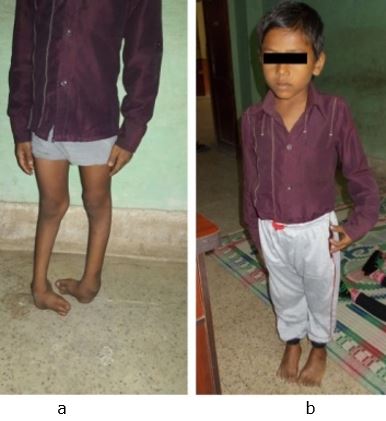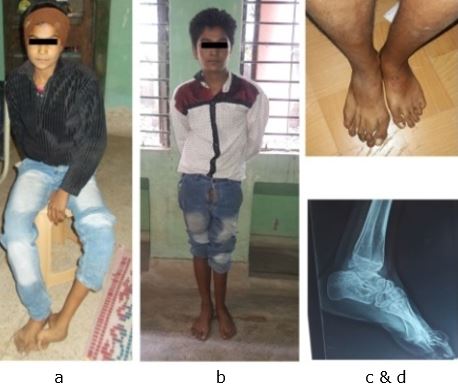Introduction
Club foot (CTEV) is among one of the most common congenital musculoskeletal defects [1]. With the introduction of the Ponseti method, treatment of congenital club foot has changed radically in most centers worldwide in favour of serial casting. However, most of these studies on Ponseti method are done in younger children, before the walking age [1,2].
Late presentation of CTEV child after walking age, is a common problem in developing countries like ours due to social stigma, lack of education, poverty and lack of proper health services [3,4]. These neglected cases when present late, after walking age are complicated by severe deformities, contractures, deformation of bones, callosities and ulcers [5].
The conservative treatment becomes difficult. In the past decades many extensive soft tissue and bony surgeries have been performed to treat such deformities of neglected cases, but the results were not very promising.
Additionally, surgeries were associated with many complications such as poor soft tissue healing and higher relapse rate. This results in significant disability, dependency of patient for activities of daily living, financial and psychological impact on the family and finally many of these patients with neglected clubfoot deformity end up living as beggars on the streets [3,4].
Inspired by some studies which showed excellent role of Ponseti method even in late presenting walking patients of club foot [6-9], we retrospectively analyzed the results and role of Ponseti method of serial casting in neglected club foot deformity, done in the clubfoot clinic of our institution.
Material and Methods
We retrospectively analyzed the records of club feet cases who had been treated by Ponseti method in the club foot clinic of our institute from April 2016 to March 2019. Only neglected cases of CTEV i.e. presenting late after the walking age or one year with idiopathic club foot, with no previous treatment were included in the study.
Secondary club foot, atypical clubfoot, non-healing ulcers, previously treated or prior surgeries done were excluded from the study. 29 cases were found eligible to be included in the study, but 6 cases were lost to follow-up after initial correction and were not available with complete follow up and hence were excluded from the study. Thus finally, only 23 cases of neglected CTEV were included in the study.
All the parents of club feet children had been found to be informed about the treatment protocol and they consented to be included as a subject in any study done by the institution. Institutional ethical committee approval was obtained.
All the patients were evaluated pre-treatment and at each visit by Pirani scoring system [10] and were treated weekly with Ponseti’s method of serial manipulation and above knee plaster cast application [2].
The feet were manipulated for approximately 10 minutes before plaster cast application. The casting continued till foot abduction to approximately 30° to 40° was achieved (instead of 70°) which is recommended for elder child [11].
Finally, the equinus deformity was corrected by a percutaneous Achilles tenotomy in all patients irrespective of the age, followed by casting with full correction. The tenotomy in younger children was performed under local anesthesia.
Spinal or general anesthesia was preferred in older children as more manipulation was expected in these cases due to presence of a more rigid equinus and cavus deformity. A repeat tenotomy of tendo-achilles was done in children where adequate dorsiflexion, i.e., at least 50 of dorsiflexion was not achieved by the first tenotomy.
In few patients percutaneous plantar fascitomy was needed to correct the residual cavus deformity. Post-tenotomy cast was removed at 3 weeks in patients aged less than 3 years and 4 weeks in patients aged more than 3 years. After the deformity was corrected, a foot abduction brace was prescribed to all patients for next one year.
Initially the brace was worn for 23 hours a day for the first 3 months and after that brace wearing was advised for night time only. Retrospective data was collected and analyzed forage at the time of presentation, severity of deformity by the Pirani score at initial presentation, change in the Pirani score after the final cast, the number of casts required to achieve full correction and any complications during the casting or bracing phase of the treatment.
The quantitative variables were expressed as mean ± standard deviation and compared between preoperative and postoperative follow-up using the paired t-test. Statistical analysis was performed and a P< 0.05 was considered statistically significant.
Results
Out of 23 cases of CTEV who presented after 1 year of age, 9 had bilateral involvement whereas 14 had unilateral deformity (32 club feet). There were 15 male and 8 female patients.
The mean age at presentation was 3.4 (range 1 to 15) years. The mean pre-correction Pirani score was 4.51 (range 2.5 to 6). The mean post-correction Pirani score was 0.55(range 0 to 1). This difference was statistically significant (p < .001).
The mean number of casts applied to achieve final correction was 9.2 casts (range 6 to 16 casts). In 95% of the feet, satisfactory correction of the deformity was achieved (fig 1& 2). The mean follow-up duration was 14.2 (range 6 to 21) months. A percutaneous Achilles tenotomy was performed in all patients with a mean ankle dorsiflexion after tenotomy of 7° (0° to 10°).
Complications noticed during the casting phase were mild and manageable. Four patients developed erythema, slight swelling of the toes and redness of the skin due to excessive pressure.




